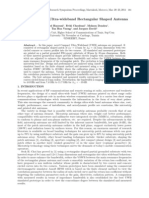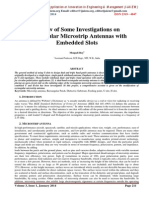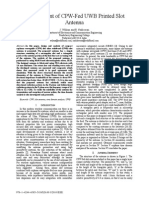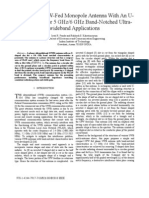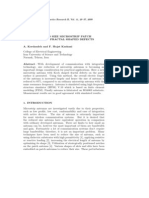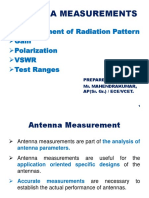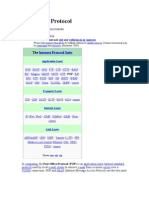Circular y Shape Slot
Circular y Shape Slot
Uploaded by
jenath1Copyright:
Available Formats
Circular y Shape Slot
Circular y Shape Slot
Uploaded by
jenath1Original Description:
Copyright
Available Formats
Share this document
Did you find this document useful?
Is this content inappropriate?
Copyright:
Available Formats
Circular y Shape Slot
Circular y Shape Slot
Uploaded by
jenath1Copyright:
Available Formats
Available online www.ejaet.
com
European Journal of Advances in Engineering and Technology, 2014, 1(1): 61-68
Research Article
ISSN: 2394 - 658X
Circularly Polarized Square Patch Microstrip Antenna with
Y- Shaped Slot for Wi-Max Application
Sumita Shekhawat1 and Vijay Sharma2
1
Department of Physics, JK Lakshmipat University, Jaipur- 302026
Department of Physics, Govt. Mahila Engineering College, Ajmer -305002
phyvijay@gmail.com
_____________________________________________________________________________________________
2
ABSTRACT
A compact design of a circularly-polarized (CP) antenna to achieve wide-band behavior for Wi- Max applications
is presented. Single feed is used to excite a single-layered square patch integrated with a novel Y-shaped slot and
two different truncated corners to achieve CP polarization. Besides its structural simplicity, ease of fabrication
and low cost, the proposed antenna features a satisfactory impedance bandwidth of value 5.76 % in the lower
frequency band of Wi-Max application (2.3GHz - 2.4GHz) and also exhibits axial ratio bandwidth 1.71%.The
measured radiation pattern of the proposed antenna demonstrates directional patterns in both E- and H-planes.
The simulated results are well in agreement with measured results.
Key words: Microstrip patch antenna, circular polarization, axial ratio, wi-max, gain
_________________________________________________________________________________
INTRODUCTION
In modern wireless communication systems patch antenna is playing a very important role for wireless service
requirements due to its characteristics such as small size, light weight, low profile and low cost. Wireless local area
network (WLAN) and Worldwide Interoperability for Microwave Access (WiMAX) have been widely applied in
mobile devices such as handheld computers and intelligent phones. These two techniques have been widely
recognized as a viable, cost-effective, and high-speed data connectivity solution, enabling user mobility. In
practice, IEEE 802.11 standard covers the WiMAX frequency for the lower band of 2.3-2.4 GHz, for median band
and upper band 3.5-GHz (3.33.6 GHz) and 5.5-GHz (5.255.85 GHz) frequency bands [1]. The increasing
demand of wireless and mobile communication systems has increased the demand for smaller devices with wider
bandwidth. The limitation of the transmitter-to-receiver orientation can be effectively solved when antennas with
circular polarization (CP) are utilized. Circular polarized (CP) antenna can reduce the loss caused by misalignment
between the signal and the receiving antenna. The CP wave obtained two degenerated orthogonal modes with
different resonant frequencies and there is a phase difference of 90 between two orthogonal modes. Antennas
following these trends must be compact in size and they must have the capability to integrate with host object with
desired impedance behavior and radiation characteristics. Circular polarization (CP) operation may be obtained by
certain modifications to the basic antenna either in geometry and/or feed [2].
Various single- and dual-band CP patch antennas have been investigated and reported in literature. Such as in [3], a
single-feed square patch was truncated at its corners to obtain CP, which typically results in narrow axial-ratio
bandwidths. This design involves four slits incorporated into a square patch for circular polarization at 2.2 GHz
with an axial ratio bandwidth of about 1.62 %. In [4], another truncated-corner antenna with the aid of several slits
produced CP and an axial ratio bandwidth of around 1.45 % at 2.45 GHz has achieved by researchers. This
structure offers a size reduction of about 36 % compared to conventional truncated corner CP antenna designs.
In recent time our group has designed and discussed many CP antennas with various shapes for practical use in
Wi- Max and other applications in open literature [5 -11]. In [5], a dual band circularly polarized single-feed
modified rectangular microstrip antenna having one protruded curved edge for wireless communication systems is
61
Sumita Shekhawat and Vijay Sharma
Euro. J. Adv. Engg. Tech., 2014, 1(1):61-68
______________________________________________________________________________
proposed. This designed antenna operates at two frequencies 3.10 GHz and 3.55 GHz and presents circularly
polarized performance in far-field region. The measured impedance bandwidth of designed antenna is 26% (0.846
GHz) with respect to the central frequency 3.31 GHz. The axial ratio bandwidth at two frequencies 3.10 GHz and
3.55 GHz is close to 1.36% & 2.21% respectively. In [6], a wideband gap coupled assembly of rectangular
microstrip patches applicable in lower and upper band of Wi-Max applications utilizing six directly and
parasitically coupled patches is discussed. The proposed antenna is designed to function in the lower band (2.4 2.69 GHz) and upper band (5.25-5.85 GHz) of Wi-Max systems. In [7] the design and performance of a modified
semi elliptical microstrip patch antenna is proposed to achieve circularly polarized broadband performance. The
proposed structure consists of a semi-elliptical patch having a D-shaped slot designed on three layered substrate
material. In [8], the design and performance of a novel single-layer assembly of gap coupled elements in elliptical
shape is proposed to achieve broadband performance with circular polarization. In [9] the radiation performance of
broadband circularly polarized gap-coupled arrangement of rectangular patches is reported which consists of three
rectangular patches having separation between them. The central designed patch is excited through a single inset
feed point while the other two patches are gap coupled to the central patch. The antenna provides nearly 12%
impedance bandwidth with circularly polarized radiation. In [10], the design of a compact multi-band elliptical
patch antenna with a narrow sector slot multi-band operation is discussed. The measured results shows that antenna
is capable in resonating at frequencies 2.66 GHz, 3.86 GHz and 5.46 GHz at atime enabling its possible application
in Wi-MAX communication systems in all three bands. In [11], the design and analysis of a single feed stacked
square patch using tuning stubs is proposed which is capable in providing circular polarization along with
broadband performance. The axial ratio obtained at two frequencies 2.3GHz and 2.66GHz are 1.61dBi and
0.45dBi. In [12], a novel dual-frequency broadband design of a single-layer single-feed circular microstrip antenna
with an off-centered Y-slot is demonstrated by selecting an appropriate location of the Y-slot in the circle.
In other research articles such as in [13], the CP characteristics are achieved by an unequal cross-slot embedded in
the circular patch and two orthogonal linear stubs spurred from the annular-ring with small frequency ratio (about
1:1.1). In [14] to achieve simultaneous dual-band CP and a wide impedance bandwidth, researchers proposed the
asymmetrical U-slot and achieved axial ratio bandwidths of 1 % and 3.1 % in lower and higher bands. In [15] a
single-layered feed is used to excite a single square patch integrated with a novel asymmetrical slot and two
different truncated corners to achieve CP polarization in two bands. An impedance bandwidth of 7.2 % in the
lower band (2.53 GHz) and 3.6 % in the upper band (5.73 GHz) with a 3 dB axial ratio of 2 % and 3.2 % in the
lower and upper band respectively is achieved.
In this paper, the investigation is done on a single-layer single feed corner truncated square patch antenna, having a
narrow Y-slot. In first step the square radiating patch is truncated at two corners (diagonally) and thereafter in
second step two rectangular slots which are perpendicular to each other are cut at the center of the patch. These
two rectangular slots appears like Y, therefore we call it Y-Slot. The proposed antenna is fed by using coaxial
probe feed. The simulated reflection coefficient, gain, and axial ratio bandwidth are compared with measured
results. Results show that the proposed antenna has very small size, wide bandwidth, moderate gain and very good
axial ratio bandwidth in comparison to conventional patch antenna of same size.
ANTENNA DESIGN AND PARAMATRIC ANALYSIS
In first step a conventional square patch antenna (without any slot / modification) is analyzed with a ground plane
size of 50 60 mm2. The glass epoxy FR4 substrate having relative permittivity, r = 4.4, loss tangent, tan = 0.025
and height h =1.59 mm is used, with a fully-metalized reverse side as its ground. The size of square patch is 30 30
mm2. The antenna is fed through simple coaxial probe feed enable to match with 50 input impedance. The
resonant frequency of a square microstrip patch can be calculated by equation [1]
( fr )
1
2L r 0 0
(1)
Since it does not account for fringing, it must be modified to include edge effects. The simulated resonance
frequency corresponding to dominant mode (TE10 mode) of conventional square patch antenna is 2.33GHz, which
matches with the calculated frequency. The impedance bandwidth of this antenna is ~2.53% with a peak gain
1.22dBi. This antenna is linearly polarized having 40 dB minimum value of axial ratio. These antenna parameter
values are much lower than the desired values for practical use of antenna in modern communication systems.
This square patch antenna is therefore modified by the conventional technique of edge-truncation at the two
corners of resonator patch with a Y-shaped slot consist of two perpendicular slots at the centre gives a good CP
bandwidth as shown in fig.1. Once integrated onto the square patch, two orthogonal modes with a quadrature phase
for CP generation are enabled. Extensive parametric analysis is carried out with modified conventional square
62
Sumita Shekhawat and Vijay Sharma
Euro. J. Adv. Engg. Tech., 2014, 1(1):61-68
______________________________________________________________________________
patch antenna by varying dimension of truncation at the two corners, length (L) and width (W) of two
perpendicular slots at the centre of patch using IE3D simulation software [11], the results obtained are presented
below. An antenna with axial ratio smaller than 3dB may be considered as antenna. Therefore in order to check
whether our antenna is circularly polarized or not; we have studied the simulated axial ratio variation with
frequency for each variation.
Fig 1 Geometry of proposed antenna
Effect of Truncation
On applying truncation of appropriate dimension at the two opposite sides of a conventional square antenna it
gives circular polarized radiation along with improved impedance bandwidth. First of all truncation area is
optimized. The variation of axial ratio value with frequency for different truncation area is plotted in fig.2. From
fig. 2 it can also be concluded that on making truncation area 3mm x 3mm maximum axial ratio bandwidth
(1.251%) with minimum axial ratio value (0.47dB) is obtained. On decreasing or increasing truncation size further;
axial ratio increases again. It is observed from simulations that creating truncation of corners facilitates the
lowering of the axial ratio. Moreover, the corners are also utilized to reverse the negative effect of the parasitic
slots on the axial ratio.
Fig 2 Variation of axial ratio with frequency for different truncation area
Effect of Slot Dimensions (Length & Width)
For pure circular polarization the value of axial ratio should be 0 dB therefore we have further modified this
truncated square patch by inserting a rectangular slot along the diagonal, maintaining the symmetry of geometry so
that same geometry may be used to achieve right hand circular polarization and left hand circular polarization. The
variation of axial ratio bandwidth and minimum value of axial ratio with length and width of slot is shown in fig. 3
63
Sumita Shekhawat and Vijay Sharma
Euro. J. Adv. Engg. Tech., 2014, 1(1):61-68
______________________________________________________________________________
and fig.4 respectively. It is observed from figures that applying a narrow slot of dimensions length L = 3.2mm and
W=0.5mm inclined at 450 to horizontal axis, a maximum axial ratio bandwidth with minimum value of axial ratio
may be achieved. The minimum axial ratio in this condition is close to 0.453 while the axial ratio bandwidth with
respect to central frequency 2.36GHz is close to 1.322%.
Fig 3 Variation of A.R bandwidth and minimum A.R with length of slit
Fig 4 Variation of A.R bandwidth and minimum A.R with width of slit
The purity of polarization is further tried to improve by inserting another narrow rectangular slit of width
(W=0.5mm ) and length (L/2=1.6mm) perpendicular to first slit of width (W) and length (L), which looks like Y shaped slit. This second slit is inclined at an angle 1350 with respect to horizontal x-axis. From fig.5 it is observed
that on inserting two slits at the centre, axial ratio is minimum having a value 0.08 dB which is comparable to 0dB,
without any compromise with axial ratio band width. After doing all these optimization a prototype has fabricated
with following dimensions as shown in fig. 6.
Fig 5 Variation of A.R bandwidth with frequency for two cases
64
Sumita Shekhawat and Vijay Sharma
Euro. J. Adv. Engg. Tech., 2014, 1(1):61-68
______________________________________________________________________________
Fig. 6 Geometry of modified corner truncated square patch antenna
RESULTS AND DISCUSSION
For the measurement propose, this corner truncated square patch with Y-slot is fed through coaxial probe feed
using SMA connector. The reflection coefficient and input impedance are measured by using Vector Network
Analyzer and radiation patterns are measured in anechoic chamber. Fig. 7 & 8 depicts the variation of simulated
and measured reflection coefficient of corner truncated square patch with Y-slot in the frequency range 2.2-2.6
GHz. These results suggest that simulated resonance frequencies for proposed antenna are 2.339GHz and
2.379GHz whereas the measured resonance frequencies are 2.316GHz and 2.387. The simulated impedance
bandwidth of this modified antenna is 130 MHz while measured impedance bandwidth of antenna is 136MHz. The
measured results suggest that the presence of Y-shaped slot has improved the impedance bandwidth of antenna
marginally.
Fig. 7 Variation of reflection coefficient of modified square
patch antenna with frequency
Fig. 8 Variation of measured reflection coefficient of modified
square patch antenna with frequency
Fig. 9: Variation of simulated input impedance of modified
square patch antenna with frequency
Fig. 10: Variation of measured input impedance of modified square
patch antenna with frequency
65
Sumita Shekhawat and Vijay Sharma
Euro. J. Adv. Engg. Tech., 2014, 1(1):61-68
______________________________________________________________________________
The variation of simulated and measured input impedance of modified antenna with frequency is shown in fig. 9
and 10 respectively. The input impedance curve in both the cases depicts the presence of a sharp notch in desired
range of frequency, which indicates the presence of circularly polarized radiations. The purity of circular
polarization demands presence of input impedance variation with frequency. If the two degenerate modes which
are necessary for obtaining circular polarization are very close to each other then the loop area becomes zero and
presents a sharp notch. In simulated result sharp dip is observed at frequency 2.36GHz whereas in measured result
it is at 2.35GHz which is well in agreement.
The main target behind designing of this structure was to achieve circular polarization in addition to improvement
in impedance bandwidth of antenna. By optimizing the dimension of corner truncation and inserted Y-slot, both
these targets were achieved. The comparison of measured and simulated axial ratio of prototype antenna is shown
in fig. 11 which shows a slight variation in measured axial ratio band width (1.71%) and the simulated axial ratio
bandwidth (1.32%), which is perhaps due to measurement errors. Both impedance bandwidth (5.76%) and axial
bandwidth (1.71%) are improved in comparison to that at of a conventional square patch antenna fed under similar
conditions. The variation of simulated and measured gain value of antenna as a function of frequency is shown in
fig. 12, which indicates that gain of antenna is less than 2dBi which is nearly the same achieved with a
conventional square patch antenna. No variation in gain of antenna in the entire bandwidth range is realized.
Fig. 11 Variation of simulated and measured axial ratio of modified square patch antenna with frequency
Fig. 12 Variation of measured and simulated gain of modified square patch versus frequency
The two dimensional measured E-plane co and cross polarization radiation patterns of proposed antenna at two
frequencies 2.31GHz and 2.38GHz (corresponding to -10dB scale) are shown in fig. 13 and 14 respectively. At
frequency 2.31GHz, the co polar patterns in E plane are nearly 14 dB higher than cross polar patterns while at
frequency 2.38GHz, the co polar patterns in E plane are nearly 12 dB higher than cross polar patterns. The
direction of maximum radiation intensity is normal to the patch geometry. The radiation patterns of modified
antennas are identical in shape and nature in the entire bandwidth range. The simulated 3dB beam width at
frequency 2.38 is nearly 100 0 while at frequency 2.31GHz it is only 60 0. An overall comparison in the performance
of proposed modified square patch antenna with conventional square patch antenna is reported in Table 1.
Table - 1 Comparison between the Radiation Performances of Simple Square Patch, Truncated Square Patch and Truncated Square
Patch Antenna with Y-slot
Antenna Geometries
Resonance Frequency
Impedance Bandwidth
Min A.R Value
A.R Bandwidth
(GHz)
(%)
(dB)
(%)
Simple Square patch
2.33
2.1
40
0
Truncated Square Patch
2.349
5.24
0.478
1.251
Truncated Square With Y- slot
2.316, 2.386
5.76
0.092
1.71
66
Sumita Shekhawat and Vijay Sharma
Euro. J. Adv. Engg. Tech., 2014, 1(1):61-68
______________________________________________________________________________
Fig. 13 Measured E-plane radiation pattern for proposed antenna at frequency 2.31GHz
Fig. 14 Measured E-plane radiation pattern for proposed antenna at frequency 2.38 GHz
CONCLUSION
The proposed analysis suggests that by applying appropriate truncations and narrow Y-shaped slot in square patch
antenna, both impedance and axial bandwidths of antenna are improved without losing compactness of the patch
geometry. After truncation, patch area is marginally reduced but the performance of antenna is significantly
improved. On applying Y-shaped slot at the centre of truncated square the quality of circular polarization is highly
improved. The radiation patterns in entire bandwidth are identical in nature and the direction of maximum radiations
in entire bandwidth is directed normal to the patch geometry. The present antenna proved applicable for Wi-Max
application (2.3GHz-2.4 GHz).The performance of antenna in terms of gain and efficiency can be improved further
by applying better substrate material.
Acknowledgements
Authors are thankful to Mr.V.V. Srinivasan from ISRO (Indian Space Research Organization), Bangalore for
permitting to use measurement facilities available at their center. Authors are also thankful to Prof. Deepak
Bhatnagar, University of Rajasthan for his expert comments and suggestion on the paper.
REFERENCES
[1] D Guha, Yahia M M Antar, Microstrip and Printed Antennas: New Trends, Techniques and Applications, Wiley
and Sons, 2010.
[2] K L Wong, Compact and Broadband Microstrip Antennas, John Wiley & Sons, 2003.
[3] K L Wong and J Y Wu, Single-Feed Small Circularly Polarized Square Microstrip Antenna, Electronics Letters,
33, 1997, 1833-1834.
[4] W S Chen, C K Wu and K L Wong, Novel Compact Circularly Polarized Square Microstrip Antenna, IEEE
Transactions on Antennas and Propagation, 49, 2001, 340-342.
[5] Vijay Sharma and M M Sharma, Dual Band Circularly Polarized Modified Rectangular Patch Antenna for
Wireless Communication, Radio Engineering, 2014, Vol. 23, No. 1, pp. 195-202.
67
Sumita Shekhawat and Vijay Sharma
Euro. J. Adv. Engg. Tech., 2014, 1(1):61-68
______________________________________________________________________________
[6] Vijay Sharma and M M Sharma, Wideband Gap Coupled Assembly of Rectangular Microstrip Patches for WiMax Applications, Frequenz Journal of RF-Engineering and Telecommunications, 2013, Vol. 68, pp. 25-31.
[7] B R Sharma, Vijay Sharma, A Tiwari, D Bhatnagar and K B Sharma, Design and Performance of a Broadband
Circularly Polarized Modified Semi Elliptical Patch Antenna, Proceeding of SPIE (International Society for Optics
and Photonics), vol. 8760, 2013, 87602 E1 E6.
[8] Vijay Sharma, V K Saxena, K B Sharma and D Bhatnagar, Radiation Performance of Circularly Polarized
Broadband Gap Coupled Elliptical Patch Antenna, Frequenz Journal of RF-Engineering and Telecommunications,
2012, Vol. 66, 69-74.
[9] P Sekra, S Shekhawat, D Bhatnagar, V K Saxena, J S Saini and L M Joshi, Broadband Circularly Polarized GapCoupled Arrangement of Rectangular Patches for Modern Communication Systems, Microwave Optical Tech.
Letters, 2011, 53, 947-952.
[10] Vijay Sharma, V K Saxena, K B Sharma and D Bhatnagar, Multi-Band Elliptical Patch Antennas with Narrow
Sector Slot for Wi-MAX Applications, International Journal of Microwave and Optical Technology, 2012, Vol.7,
No2. pp. 89-96.
[11] Vijay Sharma, B R Sharma, V K Saxena, K B Sharma, M M Sharma & D Bhatnagar, Circularly Polarized
Stacked Square Patch Microstrip Antenna with Tuning Stubs, Work Shop on Advanced Antenna Technology (IEEE
Indian Antenna Week 2011), Dec. 2011.
[12] Sumita Shekhawat, Pratibha Sekra, V K Saxena, J S Saini and D Bhatnagar, Circular microstrip antenna with
off-centered Y-slot, International Journal of RF and Microwave Computer-Aided Engineering, 2011, Vol. 21, Issue
4, pp 407412.
[13] W Liao and Q X Chu, Dual-Band Circularly Polarized Microstrip Antenna with Small Frequency Ratio,
Progress in Electromagnetics Research Letters, 2010, 15, 145-152.
[14] P Nayeri., K F Lee, A Z Elsherbeni and Fan Yang, Dual-Band Circularly Polarized Antennas using Stacked
Patches with Asymmetric U-slots, IEEE Trans. on Antennas and Wireless Propagation Letters, 2011, 10, 285-288.
[15] S M Noghabaei, S K A Rahim, P J Soh, M Abedian, G A E A Vandenbosch, Dual-band Circularly-Polarized
Patch Antenna With a Novel Asymmetric Slot for Wi-Max Application, Radio Engineering, 2013, vol. 22, pp. 291295.
[16] IE3D, Zeland Software, Inc., Freemont, USA, 2007.
68
You might also like
- How To Openline (Unlock) and Debrand Huawei E5573cs-933 (Globe)Document5 pagesHow To Openline (Unlock) and Debrand Huawei E5573cs-933 (Globe)Abraham MolinaNo ratings yet
- CCNA 3 Case Study Spring 2022Document7 pagesCCNA 3 Case Study Spring 2022Mohammed El-SaadiNo ratings yet
- Backup Intake FormDocument9 pagesBackup Intake Formpuneetgoyal100No ratings yet
- A Novel Compact Ultra-Wideband Rectangular Shaped AntennaDocument5 pagesA Novel Compact Ultra-Wideband Rectangular Shaped AntennaBilal SaleemNo ratings yet
- 8 Vol 17 No 2Document7 pages8 Vol 17 No 2Sanjay SumanNo ratings yet
- Review of Some Investigations On Rectangular Microstrip Antennas With Embedded SlotsDocument8 pagesReview of Some Investigations On Rectangular Microstrip Antennas With Embedded SlotsInternational Journal of Application or Innovation in Engineering & ManagementNo ratings yet
- 03.08010804 V Sahaded AntennaDocument10 pages03.08010804 V Sahaded AntennaMahmoud NaguibNo ratings yet
- Published Motl LibreDocument4 pagesPublished Motl LibrebooksNo ratings yet
- Design and Analysis of Microstrib-Fed Band Notch Uwb AntennaDocument6 pagesDesign and Analysis of Microstrib-Fed Band Notch Uwb AntennaInternational Journal of computational Engineering research (IJCER)No ratings yet
- Cpw-Fed Slot Patch Antenna For 5.2/5.8 GHZ Wlan ApplicationDocument3 pagesCpw-Fed Slot Patch Antenna For 5.2/5.8 GHZ Wlan ApplicationWish MasterNo ratings yet
- Co-Axial Feed O' Slot Circularly Polarized Corner Truncated Rectangular Micro-Strip Patch AntennaDocument4 pagesCo-Axial Feed O' Slot Circularly Polarized Corner Truncated Rectangular Micro-Strip Patch AntennamonikaNo ratings yet
- D Ece-142Document6 pagesD Ece-142nilegyi771No ratings yet
- Progress in Electromagnetics Research Letters, Vol. 31, 97-105, 2012Document9 pagesProgress in Electromagnetics Research Letters, Vol. 31, 97-105, 2012iccwcsNo ratings yet
- Cognetive RedioDocument10 pagesCognetive RedioNIET14No ratings yet
- Antenna Efficiency and Gain of Two New Compact Microstrip AntennnasDocument9 pagesAntenna Efficiency and Gain of Two New Compact Microstrip AntennnaskillerjackassNo ratings yet
- Design Analysis of Slotted Diagonal Shape Patch Antenna With Hybrid CouplerDocument6 pagesDesign Analysis of Slotted Diagonal Shape Patch Antenna With Hybrid CouplerIJERDNo ratings yet
- Review Paper For Circular Microstrip Patch Antenna: ISSN 2249-6343Document4 pagesReview Paper For Circular Microstrip Patch Antenna: ISSN 2249-6343Charan Macharla'sNo ratings yet
- Planar Band-Notched Ultra-Wideband Antenna With Square-Looped and End-Coupled ResonatorDocument7 pagesPlanar Band-Notched Ultra-Wideband Antenna With Square-Looped and End-Coupled ResonatorNidhi PanditNo ratings yet
- Design of Triple-Frequency Microstrip-Fed Monopole Antenna Using Defected Ground StructureDocument7 pagesDesign of Triple-Frequency Microstrip-Fed Monopole Antenna Using Defected Ground StructurenripinthampanNo ratings yet
- A CPW-Fed Novel Planar Ultra-Wideband Antenna With A Band-Notch CharacteristicDocument5 pagesA CPW-Fed Novel Planar Ultra-Wideband Antenna With A Band-Notch CharacteristicarbtepNo ratings yet
- Design of Broadband Circular Patch Microstrip Antenna With Diamond Shape SlotDocument0 pagesDesign of Broadband Circular Patch Microstrip Antenna With Diamond Shape SlotNgoc Lan NguyenNo ratings yet
- A Compact Dual Band Planar Branched Monopole Antenna For DCS2.4-GHz WLAN ApplicationsDocument3 pagesA Compact Dual Band Planar Branched Monopole Antenna For DCS2.4-GHz WLAN ApplicationspsgshyamNo ratings yet
- Asymmetric Ground Structured Circularly Polarized Antenna For ISM and WLAN Band ApplicationsDocument9 pagesAsymmetric Ground Structured Circularly Polarized Antenna For ISM and WLAN Band ApplicationsAbirami RajeshNo ratings yet
- A Critical Review On Micro Strip Patch ADocument7 pagesA Critical Review On Micro Strip Patch AMirela CimpanuNo ratings yet
- Circularly Polarized ArrowheadDocument12 pagesCircularly Polarized ArrowheadNatwar LalNo ratings yet
- K Khalil, P S Excell, M M Ibrahim and R Alias: 02W3 Insbtute Elecfrical Printedand Published IEE. Michael Faradav WavDocument4 pagesK Khalil, P S Excell, M M Ibrahim and R Alias: 02W3 Insbtute Elecfrical Printedand Published IEE. Michael Faradav WavJohn WilliamsNo ratings yet
- 60 GHZDocument9 pages60 GHZjackofmanytradesNo ratings yet
- 8.design of An S-Band Rectangular Microstrip Patch AntennaDocument8 pages8.design of An S-Band Rectangular Microstrip Patch Antennasrinivas08427No ratings yet
- V5i3 Ijertv5is030037Document5 pagesV5i3 Ijertv5is030037Ramya RNo ratings yet
- Modeling and Simulation of Slot Loaded Rectangular Microstrip Patch AntennaDocument5 pagesModeling and Simulation of Slot Loaded Rectangular Microstrip Patch AntennaArnav GudduNo ratings yet
- Slot Loaded Microstrip Antenna For GPS, Wi-Fi, and Wimax Applications SurveyDocument6 pagesSlot Loaded Microstrip Antenna For GPS, Wi-Fi, and Wimax Applications Surveywarse1No ratings yet
- A Miniaturized Monopole Antenna With Triple-Notch Filters For UWB ApplicationsDocument5 pagesA Miniaturized Monopole Antenna With Triple-Notch Filters For UWB Applicationsa.zitouniNo ratings yet
- Design of Wideband Circularly Polarized Capacitive Fed Microstrip AntennaDocument8 pagesDesign of Wideband Circularly Polarized Capacitive Fed Microstrip AntennanripinthampanNo ratings yet
- A Modified E Shaped Patch Antenna For Mimo Systems: K. Jagadeesh Babu Dr.K.Sri Rama Krishna Dr.L.Pratap ReddyDocument4 pagesA Modified E Shaped Patch Antenna For Mimo Systems: K. Jagadeesh Babu Dr.K.Sri Rama Krishna Dr.L.Pratap ReddyKrashnkant GuptaNo ratings yet
- 15 IJAERS-DeC-2014-31-Effect of Cavity in Substrate On Multiband Circular Micro-Strip Patch AntennaDocument5 pages15 IJAERS-DeC-2014-31-Effect of Cavity in Substrate On Multiband Circular Micro-Strip Patch AntennaIJAERS JOURNALNo ratings yet
- Enhanced Bandwidth Multiband Slot Antenna For Portable DevicesDocument4 pagesEnhanced Bandwidth Multiband Slot Antenna For Portable DevicesInternational Journal of Research in Engineering and TechnologyNo ratings yet
- Mircostrip Patch Antenna With E Shaped Structure For S-Band ApplicationsDocument5 pagesMircostrip Patch Antenna With E Shaped Structure For S-Band ApplicationsijsretNo ratings yet
- Progress in Electromagnetics Research Letters, Vol. 36, 41-55, 2013Document15 pagesProgress in Electromagnetics Research Letters, Vol. 36, 41-55, 2013Usman SiddiqNo ratings yet
- A Novel Fractal Patch Antenna For UWB ApplicationsDocument4 pagesA Novel Fractal Patch Antenna For UWB ApplicationsGibran ZuñigaNo ratings yet
- Broadband Circularly Polarized Microstrip Patch Antenna Using Circular Artificial Ground Structure and Meandering ProbeDocument11 pagesBroadband Circularly Polarized Microstrip Patch Antenna Using Circular Artificial Ground Structure and Meandering Probeamey salunkeNo ratings yet
- A Novel Design of Folded Dipole For Broadband Printed Yagi-Uda AntennaDocument8 pagesA Novel Design of Folded Dipole For Broadband Printed Yagi-Uda AntennammasoumianNo ratings yet
- Ijres V8i5p105Document5 pagesIjres V8i5p105Rachid DakirNo ratings yet
- Square Patch Micro Strip Antenna DesignDocument7 pagesSquare Patch Micro Strip Antenna DesignSrinivas AerodromeNo ratings yet
- Design and Analysis of Frequency Reconfigurable Microstrip Patch Antenna For WLAN ApplicationsDocument6 pagesDesign and Analysis of Frequency Reconfigurable Microstrip Patch Antenna For WLAN Applicationspoo235No ratings yet
- Development of CPW-Fed UWB Printed Slot Antenna: J. William and R. NakkeeranDocument5 pagesDevelopment of CPW-Fed UWB Printed Slot Antenna: J. William and R. NakkeeranNag ChallaNo ratings yet
- Heuristic Design of CPW-Fed UWB Slot AntennaDocument4 pagesHeuristic Design of CPW-Fed UWB Slot Antennaaboabdo1No ratings yet
- Design and Analysis of Micro Strip Antenna Using Hfss SoftwareDocument6 pagesDesign and Analysis of Micro Strip Antenna Using Hfss SoftwareSaikrishnaChokkapuNo ratings yet
- A Compact CPW-Fed Monopole Antenna With An UShapedDocument4 pagesA Compact CPW-Fed Monopole Antenna With An UShapedJessada KonpangNo ratings yet
- Antenna ResearchDocument8 pagesAntenna ResearchKishor.ece. anuNo ratings yet
- Miniaturised Coplanar Waveguide-Fed Antenna and Band-Notched Design For Ultra-Wideband ApplicationsDocument13 pagesMiniaturised Coplanar Waveguide-Fed Antenna and Band-Notched Design For Ultra-Wideband ApplicationsbudituxNo ratings yet
- Broadband Circular Polarized Field Generation in Single Layer Microstrip Patch AntennasDocument4 pagesBroadband Circular Polarized Field Generation in Single Layer Microstrip Patch Antennasfahmanda IdyantoNo ratings yet
- Patra2018 PDFDocument7 pagesPatra2018 PDFAnkurNo ratings yet
- IMS2013 MElmansouri FinalDocument3 pagesIMS2013 MElmansouri FinalMohamed LibyaNo ratings yet
- Controllable Band-Notched UWB Printed Monopole AntennaDocument5 pagesControllable Band-Notched UWB Printed Monopole AntennaInnovative Research PublicationsNo ratings yet
- Progress in Electromagnetics Research, Vol. 120, 499-512, 2011Document14 pagesProgress in Electromagnetics Research, Vol. 120, 499-512, 2011Mario2545No ratings yet
- Design of A Multiband Hexagonal Patch Antenna For Wireless Communication SystemsDocument9 pagesDesign of A Multiband Hexagonal Patch Antenna For Wireless Communication Systemsamankatiyar2102No ratings yet
- Eai 28-6-2020 2298173Document9 pagesEai 28-6-2020 2298173zeadzizo715No ratings yet
- Ijecet: International Journal of Electronics and Communication Engineering & Technology (Ijecet)Document5 pagesIjecet: International Journal of Electronics and Communication Engineering & Technology (Ijecet)IAEME PublicationNo ratings yet
- A Dual-Feed Dual-Band L-Probe Patch AntennaDocument3 pagesA Dual-Feed Dual-Band L-Probe Patch AntennaCRoberto Wah GonzalezNo ratings yet
- Design of Square Miniaturized L Band Fractal AntennaDocument6 pagesDesign of Square Miniaturized L Band Fractal AntennaIJMTERNo ratings yet
- A New Reduced Size Microstrip Patch Antenna With Fractal Shaped DefectsDocument9 pagesA New Reduced Size Microstrip Patch Antenna With Fractal Shaped DefectssharmabinNo ratings yet
- Radio Frequency Identification and Sensors: From RFID to Chipless RFIDFrom EverandRadio Frequency Identification and Sensors: From RFID to Chipless RFIDNo ratings yet
- Antenna ArrayDocument13 pagesAntenna Arrayjenath1100% (1)
- WC PPT Unit IIIDocument73 pagesWC PPT Unit IIIjenath1No ratings yet
- EC2255 Control Systems QBDocument16 pagesEC2255 Control Systems QBjenath1No ratings yet
- AWP Unit 5 Sky Wave PropagationDocument48 pagesAWP Unit 5 Sky Wave Propagationjenath1100% (1)
- Tdma 2Document28 pagesTdma 2jenath1No ratings yet
- Helical Antenna PresentationDocument17 pagesHelical Antenna Presentationjenath10% (1)
- EC6602 Uw 2Document451 pagesEC6602 Uw 2jenath1No ratings yet
- AWP Unit 4 Antenna MrasurementDocument45 pagesAWP Unit 4 Antenna Mrasurementjenath1No ratings yet
- Impulse Response Model of A Multipath ChannelDocument5 pagesImpulse Response Model of A Multipath Channeljenath1No ratings yet
- Arrayantennas 130710100320 Phpapp01Document20 pagesArrayantennas 130710100320 Phpapp01jenath1No ratings yet
- 3.linl Budget DesignDocument17 pages3.linl Budget Designjenath1No ratings yet
- Cellular ConceptDocument33 pagesCellular Conceptjenath1No ratings yet
- hAND OFFDocument22 pageshAND OFFjenath1100% (1)
- Interference and System CapacityDocument9 pagesInterference and System Capacityjenath1No ratings yet
- MS Antenna Array PDFDocument3 pagesMS Antenna Array PDFjenath1No ratings yet
- Two Mark High SpeedDocument13 pagesTwo Mark High Speedjenath1No ratings yet
- Traffic Model and EngineeringDocument16 pagesTraffic Model and Engineeringjenath1No ratings yet
- RSP 3332 Sistema RedundanteDocument29 pagesRSP 3332 Sistema RedundanteAdan LopezNo ratings yet
- Cyberoam Certified Network & Security Professional (CCNSP) : LearningDocument117 pagesCyberoam Certified Network & Security Professional (CCNSP) : LearningZiad AbdoNo ratings yet
- Ad Planning WorksheetsDocument20 pagesAd Planning WorksheetsJennifer LeesNo ratings yet
- Implementing Cisco Enterprise Advanced Routing and Services (ENARSI) v1.0 (300-410) - Full AccessDocument62 pagesImplementing Cisco Enterprise Advanced Routing and Services (ENARSI) v1.0 (300-410) - Full AccessShawnNo ratings yet
- 3750 Cross Stack EtherchannelDocument9 pages3750 Cross Stack EtherchannelNama Saya ApieNo ratings yet
- Question PaperDocument3 pagesQuestion PaperPrahasNo ratings yet
- Post Office ProtocolDocument6 pagesPost Office ProtocolbhaktarajjNo ratings yet
- DCS - First Sem SyllabusDocument4 pagesDCS - First Sem Syllabusbhakarsharwan6No ratings yet
- Paid Internships OpportunitiesDocument1 pagePaid Internships OpportunitiesTricks BulletinNo ratings yet
- Design of Ipsec Virtual Private Network For Remote Access: Dnyanesh Deshmukh and Brijesh Iyer, Member, IeeeDocument4 pagesDesign of Ipsec Virtual Private Network For Remote Access: Dnyanesh Deshmukh and Brijesh Iyer, Member, IeeejohanNo ratings yet
- Red Hat Enterprise Linux 6 Deployment Guide en USDocument890 pagesRed Hat Enterprise Linux 6 Deployment Guide en USSigfred NakihidNo ratings yet
- The Internet StructureDocument13 pagesThe Internet StructureHenriNo ratings yet
- ECW7220-L: DatasheetDocument3 pagesECW7220-L: DatasheetMert Eren KarabulutNo ratings yet
- Cat B25 User ManualDocument40 pagesCat B25 User ManualjimgblkNo ratings yet
- Nokia 208 - Quick Start GuideDocument3 pagesNokia 208 - Quick Start GuideSorin NemesNo ratings yet
- LKSN2023 ITNSA MC Actual enDocument10 pagesLKSN2023 ITNSA MC Actual enRizan Abki C.No ratings yet
- Monitoring-Times Magazine Dec 1996Document116 pagesMonitoring-Times Magazine Dec 1996Benjamin DoverNo ratings yet
- Syllabus Computer and Network Security Subject Code: ECE-803 L T P: 2 1 0 Credits: 03Document4 pagesSyllabus Computer and Network Security Subject Code: ECE-803 L T P: 2 1 0 Credits: 03mahwashNo ratings yet
- 8.8R1 Release Notes RevcDocument71 pages8.8R1 Release Notes RevcVillage MegdoulNo ratings yet
- Catalogue BE Educational 2017Document21 pagesCatalogue BE Educational 2017Shahzad IslahiNo ratings yet
- Fundamental of Cyber SecurityDocument2 pagesFundamental of Cyber Securitymanoj998620No ratings yet
- Diameter Protocol Introduction - Base & DCCA - 20131128Document32 pagesDiameter Protocol Introduction - Base & DCCA - 20131128Tsai Chunyeh100% (2)
- LTEDocument23 pagesLTEShwetha Ha100% (1)
- Backgroundofcommunication Systems20201Document2 pagesBackgroundofcommunication Systems20201Vũ Hoàng LongNo ratings yet
- Hawk-M Uhd 6K: Board SchematicDocument53 pagesHawk-M Uhd 6K: Board SchematicJosé Edilson da PazNo ratings yet
- Cisco Estimate - KAFD Project - District RoutersDocument1 pageCisco Estimate - KAFD Project - District RoutersSajeda M. Al-TalafhaNo ratings yet
- Cyber Threat Assessment-2021-04-05-0644 - 89Document16 pagesCyber Threat Assessment-2021-04-05-0644 - 89Simon SarmientoNo ratings yet




